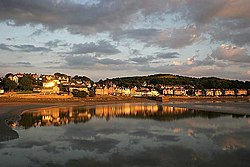River Kent
The River Kent is a short river in Westmorland. The river rises amongst the fells hills surrounding Kentmere, and flows for around 20 miles into the north of Morecambe Bay. The upper reaches of the river are within the Lake District National Park.
The river gives its name to the town of Kendal ("Kent-dale").
The estuary of the Kent broadens to soe two miles and the channel of the river continues for several miles through the sands of Morecambe Bay before being lost in the Irish Sea, revealed at low tide. Until the Rev Whitaker named Morecambe Bay in the eighteenth century, much of it was known as Kent Sands.
The river passes through Kentmere, Staveley, Burneside, Kendal and Sedgwick. Near Sedgwick, the river passes through a rock gorge which produces a number of low waterfalls. This section is popular with kayakers as it offers high quality whitewater for several days after rain.
The village of Arnside lies alongside the Kent estuary.
On high spring tides, a tidal bore known as the Arnside Bore forms in the estuary opposite Arnside. The wave is often about 2 feet high.
Contents
Tributaries
The rivers Mint, Sprint and River Gowan join the Kent to the north of Kendal, with the river also joined by the River Gilpin and River Winster as it nears its estuary.
Lingmell Gill (into Kentmere Reservoir)[1]
- Skeel Gill and Bryant's Gill
- Ullstone Gill
- Nunnery Beck
- Kill Gill
- Hall Gill
- Park Beck
- Hall Beck
- River Gowan
- River Sprint
- River Mint
- River Gilpin
- River Bela
- River Winster
Energy
Near the source of the river is Kentmere Reservoir, which was constructed in the mid-19th century to control the flow of the river for the benefit of water mills. The river was used to power numerous mills in the past,[1] including two at Staveley, Kentmere water mill, and also the James Cropper paper factory at Burneside. One of the weirs at Staveley produces electricity for Staveley Mill Yard by a micro hydro scheme. In 2010 planning permission was granted for a hydro-electric scheme at Kentmere.[2]
Wildlife
The river is a designated Special Area of Conservation, primarily as an important habitat for the endangered White-clawed Crayfish (Austropotamobius pallipes).[3]
Fish species include salmon and trout. In the twentieth century fish ladders were constructed alongside the dams of mill-ponds to allow migratory fish to swim up to Kentmere.
Outside links
- ↑ 1.0 1.1 "River Kent Info". http://www.knowledge.me.uk/areas/lakes/river_kent.html. Retrieved 22 April 2011.
- ↑ Allan Tunningley, "Power to the people", Westmorland Gazette, 22 July 2010
- ↑ River Kent: site details, Joint Nature Conservation Committee

